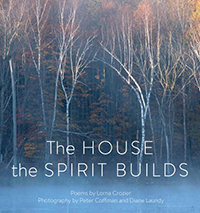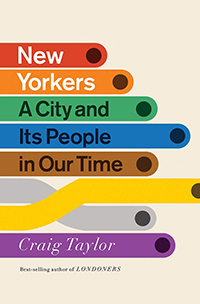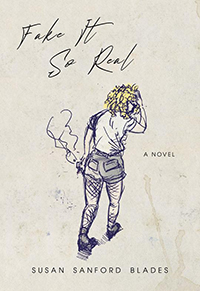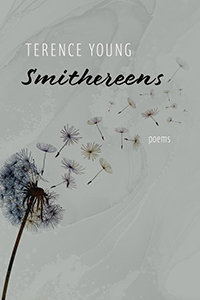Reviews
Mentionables Reviews by Jay Ruzesky
Noor Naga, Washes, Prays (Toronto: McClelland & Stewart, 2020). Paperbound, 66 pp., $19.95.
Lorna Crozier, The House the Spirit Builds (Madeira Park: Douglas & McIntyre, 2019). Paperbound, 80 pp., $22.95.
Craig Taylor, New Yorkers: A City and Its People in Our Time (Toronto: Doubleday, 2021). Hardbound, 398 pp., $39.95.
Ven Begamudré, The Teller from the Tale (Regina: Radiant Press, 2020). Paperbound, 148 pp., $20.00.
Susan Sanford Blades, Fake It So Real (Gibsons: Nightwood Editions, 2020). Paperbound, 240 pp., $21.95.
Terence Young, Smithereens (Madeira Park: Harbour Publishing, 2021). Paperbound, 112 pp., $18.95.
Keath Fraser, Charity (Windsor: Biblioasis, 2021). Paperbound, 115 pp., $17.95.
 This verse-novel, or long poem, or prose poem sequence, or poetic drama takes risks with form, and is also looking back to deep traditions of Islamic poetry. Washes, Prays has a spoken quality, and the poem examines Muslim faith while asking poignant questions about living in the contemporary world. The heart of the story is a relationship between Coocoo and an already married professor named Muhammad. The middle section of the book is from the perspective of Nouf, Coocoo’s friend, changing the lens of the story briefly and allowing even more depth to what is already a profound exploration of the connections between sensuality and devotion.
This verse-novel, or long poem, or prose poem sequence, or poetic drama takes risks with form, and is also looking back to deep traditions of Islamic poetry. Washes, Prays has a spoken quality, and the poem examines Muslim faith while asking poignant questions about living in the contemporary world. The heart of the story is a relationship between Coocoo and an already married professor named Muhammad. The middle section of the book is from the perspective of Nouf, Coocoo’s friend, changing the lens of the story briefly and allowing even more depth to what is already a profound exploration of the connections between sensuality and devotion.
 The House the Spirit Builds is a collection of poems by Lorna Crozier, and also a collection of photos by Peter Coffman and Diane Laundry. Crozier’s verse and Coffman and Laundry’s images were both composed at the Wintergreen retreat centre in the Frontenac Arch Biosphere Reserve, and the book is a dialogue between words and photographs that speaks largely of the reverent sense of the place. The colour photographs represent the meditative tone of the retreat rather than documentary: dry branches reaching over water, blue spade handle against concrete wall, snow‐dusted winding road leading to the shore, table in soft light that holds only an oil lamp, a candle, and two books. Crozier’s poems take from the spiritual quality of nature, much in the way Mary Oliver’s do, the poems themselves having drawn from the place a “language / where someone loved me.”
The House the Spirit Builds is a collection of poems by Lorna Crozier, and also a collection of photos by Peter Coffman and Diane Laundry. Crozier’s verse and Coffman and Laundry’s images were both composed at the Wintergreen retreat centre in the Frontenac Arch Biosphere Reserve, and the book is a dialogue between words and photographs that speaks largely of the reverent sense of the place. The colour photographs represent the meditative tone of the retreat rather than documentary: dry branches reaching over water, blue spade handle against concrete wall, snow‐dusted winding road leading to the shore, table in soft light that holds only an oil lamp, a candle, and two books. Crozier’s poems take from the spiritual quality of nature, much in the way Mary Oliver’s do, the poems themselves having drawn from the place a “language / where someone loved me.”
 Any particular place lives in our imagination because of its stories, so if you want to get to know a city like New York, your best bet is to talk to hundreds of people and hear their joys, woes, frustrations, and triumphs, and that is what Craig Taylor did. New Yorkers is a collection of stories told in the first person voice of a subway conductor, window cleaner, meditation teacher, nanny, dentist, dog-walker, and seventythree other varied residents of the city. The art in Taylor’s work is in convincing so many people to speak to him candidly and on the record—each story reads like a dramatic monologue that highlights some extraordinary aspect of city life. The book has been edited in such a way that the structure is compelling and the voices are juxtaposed and arranged into sections about topics like the rich, crime, building, and the pandemic. Reading through New Yorkers is as stimulating as a long urban hike from Wall Street to Washington Heights where surprise is around every corner.
Any particular place lives in our imagination because of its stories, so if you want to get to know a city like New York, your best bet is to talk to hundreds of people and hear their joys, woes, frustrations, and triumphs, and that is what Craig Taylor did. New Yorkers is a collection of stories told in the first person voice of a subway conductor, window cleaner, meditation teacher, nanny, dentist, dog-walker, and seventythree other varied residents of the city. The art in Taylor’s work is in convincing so many people to speak to him candidly and on the record—each story reads like a dramatic monologue that highlights some extraordinary aspect of city life. The book has been edited in such a way that the structure is compelling and the voices are juxtaposed and arranged into sections about topics like the rich, crime, building, and the pandemic. Reading through New Yorkers is as stimulating as a long urban hike from Wall Street to Washington Heights where surprise is around every corner.
 Collected here are three novellas that each in their way reach back to a distant past and root themselves firmly in the present. It is a cheeky sort of book that emerges out of twentieth-century post-modernism in which the present interrupts the past. “Amar’s Gift,” for example, begins, “Amar lived in a village on the shore of Moon Lake in the shadow of Fire Mountain,” but the story is quickly interrupted by the voice of the storyteller’s wife reminding him of family obligations. It’s a device that could fail, but in the hands of a seasoned writer like Begamudré, it charms the reader into seeing how these tales are as relevant in the contemporary world as they are timeless.
Collected here are three novellas that each in their way reach back to a distant past and root themselves firmly in the present. It is a cheeky sort of book that emerges out of twentieth-century post-modernism in which the present interrupts the past. “Amar’s Gift,” for example, begins, “Amar lived in a village on the shore of Moon Lake in the shadow of Fire Mountain,” but the story is quickly interrupted by the voice of the storyteller’s wife reminding him of family obligations. It’s a device that could fail, but in the hands of a seasoned writer like Begamudré, it charms the reader into seeing how these tales are as relevant in the contemporary world as they are timeless.
 Fake It So Real is an astonishing debut novel. The story is about a dysfunctional family—one that in many ways is probably closer to “conventional” families than most people would care to acknowledge. Fake It So Real has a heavy rock sensibility and the driving pace of a Babes in Toyland track. It begins with punk rock love (Gwen meets Damian) and follows the fallout of that relationship through the adult lives of the two daughters, Sara and Meg, it produces. Like the energetic music she admires, Malahat Review alumna Susan Sanford Blades infuses her language with powerful energy, and each chapter touches down on a different aspect of the family’s life so that by the end of the novel, the reader has a sense of the way generations leave their marks on one another, how they blow apart, and how they come together.
Fake It So Real is an astonishing debut novel. The story is about a dysfunctional family—one that in many ways is probably closer to “conventional” families than most people would care to acknowledge. Fake It So Real has a heavy rock sensibility and the driving pace of a Babes in Toyland track. It begins with punk rock love (Gwen meets Damian) and follows the fallout of that relationship through the adult lives of the two daughters, Sara and Meg, it produces. Like the energetic music she admires, Malahat Review alumna Susan Sanford Blades infuses her language with powerful energy, and each chapter touches down on a different aspect of the family’s life so that by the end of the novel, the reader has a sense of the way generations leave their marks on one another, how they blow apart, and how they come together.
 As a teacher and as co-founder of the Claremont Review, a literary magazine for emerging writers, Terence Young has spent many years helping budding poets hone their craft, and that attention to wellmade, artful verse is evident in his own third collection of poetry. Young experiments with forms and subjects so the poems in this book are artfully diverse and take different shapes. Surprise is a device he employs deftly as readers learn that a familiar song is in amphibrachic tetrameter, that whistles can be made from alder shoots, and that Gary lived “under a tree / for two years.” Many poems are elegies lamenting both the loss of friends and family and also of innocence and of youth. The final section of the book is an epilogue made of three poems: “What We Keep,” “What We Save for Last,” and “What Remains” that send the reader back into the bulk of the collection for a second helping of craft and wisdom.
As a teacher and as co-founder of the Claremont Review, a literary magazine for emerging writers, Terence Young has spent many years helping budding poets hone their craft, and that attention to wellmade, artful verse is evident in his own third collection of poetry. Young experiments with forms and subjects so the poems in this book are artfully diverse and take different shapes. Surprise is a device he employs deftly as readers learn that a familiar song is in amphibrachic tetrameter, that whistles can be made from alder shoots, and that Gary lived “under a tree / for two years.” Many poems are elegies lamenting both the loss of friends and family and also of innocence and of youth. The final section of the book is an epilogue made of three poems: “What We Keep,” “What We Save for Last,” and “What Remains” that send the reader back into the bulk of the collection for a second helping of craft and wisdom.
 Keath Fraser is a master storyteller and his talents are on full display in Charity, his first book of fiction in 25 years. The novella compacts a great deal of life in its pages. At once funny and shocking and moving this story is brilliantly told from the point of view of an aging stepparent—brilliant because the angle creates a sense of mystery. Could some of the things Denise is saying be accurate? The reactions of her step-daughter suggest not, but Margaret’s father (Denise’s husband) is even more outrageous. We do, however, believe that Margaret has run off to Africa with a family friend who is old enough to be her grandfather. The story has a fable-like quality, and it makes the city of Vancouver into another character in a way that reminds of Ethel Wilson’s great works. Fraser keeps the reader guessing and deeply involved right to the final stunning pages.
Keath Fraser is a master storyteller and his talents are on full display in Charity, his first book of fiction in 25 years. The novella compacts a great deal of life in its pages. At once funny and shocking and moving this story is brilliantly told from the point of view of an aging stepparent—brilliant because the angle creates a sense of mystery. Could some of the things Denise is saying be accurate? The reactions of her step-daughter suggest not, but Margaret’s father (Denise’s husband) is even more outrageous. We do, however, believe that Margaret has run off to Africa with a family friend who is old enough to be her grandfather. The story has a fable-like quality, and it makes the city of Vancouver into another character in a way that reminds of Ethel Wilson’s great works. Fraser keeps the reader guessing and deeply involved right to the final stunning pages.
—Jay Ruzesky









